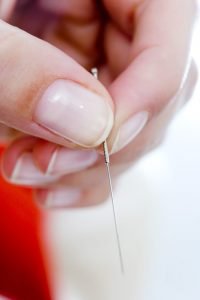
Dry Needling – In Simple Terms
Dry Needling – In Simple Terms
Read our page about Dry Needling Treatment
What is Dry Needling?
Dry Needling is the insertion of a very fine acupuncture needle (about 0.25mm in diameter) usually into muscle tissue, in an attempt to reduce muscle pain and tension. Dry needling is usually performed at the site of pain/dysfunction or very close to it. Dry needling is a type of Western medicine, performed by specially trained Health Professionals like Physiotherapists.
What is Acupuncture?
Acupuncture is a form of alternative medicine, originating from China over 2000 years ago. Acupuncture uses similar needles in an attempt to restore balance and encourage the body to heal itself. Acupuncture needles are often placed in various regions of the body, some distance from the affected area because Acupuncturists believe in restoring the flow of energy or ‘chi’. Only those trained in Chinese Medicine can label themselves as ‘Acupuncturists’.
What is a Trigger Point?
A muscular trigger point is a painful, dysfunctional area within a muscle, often referred to as a ‘knot’. Multiple factors such as arthritis, joint dysfunction, muscle fatigue, poor posture, repetitive activities and trauma can irritate or sensitize the nerves within muscle tissue and lead to the development of a trigger point.
How does Dry Needling work?
The exact mechanisms of dry needling are complex and not well understood. However, it is widely accepted that dry needling has a powerful affect on our nervous system. The insertion of needles appears to inhibit or reduce pain signals in our brain. Therefore, if dry needling is performed near a muscular trigger point, it may reduce nerve sensitivity and restore normal muscle function.
Interestingly, dry needling also causes a small increase in blood flow to the affected area, which may assist healing.
Does Dry Needling hurt?
The acupuncture needle is usually housed in a plastic tube. The first thing you will feel is this plastic tube resting against your skin. You usually don’t feel the Physiotherapist tap the needle into your skin as the needle is so fine. Now the dry needling experience will vary depending on the methods used by your Physiotherapist, your expectations, your prior experiences with needles, your level of anxiety, etc. All of these factors and many more play an important role in whether an individual interprets the experience as a painful one or not. In my experience, if you have had an unpleasant experience with needles in the past or you are anxious or stressed about dry needling, it is probably not for you. However, those with a positive attitude toward dry needling often describe it as little more than an uncomfortable experience. Once in place, the needles do not hurt, so any feeling of discomfort can be eased by simply asking the Physiotherapist to stop.
Usually the Physiotherapist will attempt to elicit a ‘local twitch response’ which is often described as a ‘mini cramp’ or ‘small electric shock’. The exact mechanism is not well understood, however it is much easier to elicit a ‘local twitch response’ in a dysfunctional muscle compared to a normal muscle. In my opinion, the effectiveness of dry needling is directly related to the number of ‘local twitch responses’ during a session.
How will I feel after my Dry Needling session?
How you feel after your dry needling session tends to depend on the intensity of the session. For example, if your Physiotherapist only uses a couple of acupuncture needles and doesn’t elicit many ‘local twitch responses’, it is likely that you will feel relatively normal after you dry needling session. If your Physiotherapist uses many acupuncture needles and elicits multiple ‘local twitch responses’, it likely that the affected muscles will feel ‘achey’ and ‘heavy’. Some describe the sensation as a ‘bruise’ or ‘cork’ which gradually eases over the next day or two. It is advisable to continue moving normally and gently stretch the affected area to reduce muscle soreness. Other techniques such as using heat, having a massage, taking anti-inflammatory medications and staying well hydrated can also help. Your muscle performance should improve and the tension should resolve within days.
How quickly does Dry Needling work and how long does it last?
You should experience positive results within two to three days of your first session of dry needling. Naturally, chronic or severe muscle dysfunction will require more dry needling sessions than minor muscle tension. You can think of dry needling as a ‘reset switch’ for muscles. If the original source of your muscle dysfunction remains present, such as joint inflammation, poor posture or repetitive activities, your muscle is likely to become dysfunctional once more. Occasionally, muscle dysfunction remains long after the original cause has resolved. In this case, dry needling can permanently improve muscle function. Physiotherapists pride themselves on their ability to find the source of your problem, provide symptomatic relief as well as a comprehensive rehabilitation program.
Is Dry Needling safe?
Dry needling a very clean technique; your Physiotherapist will use sterilized, single use, disposable acupuncture needles. There is always a small chance of infection when the skin is punctured, however we have never caused this. As the needles are so fine, there is usually no bleeding. Occasionally a small droplet of blood may appear which can result in a small bruise. Potentially a pneumothorax could occur if the needle is inserted into the lung, causing a slow air leak and potentially collapsing part of the lung. Although serious, it can be resolved in hospital. Physiotherapists are conservative and extremely well trained in Anatomy so it is very unlikely that they will cause a pneumothorax (we have never caused one).
If you have any further questions regarding dry needling, please contact us and we will be all to happy to answer them for you.
